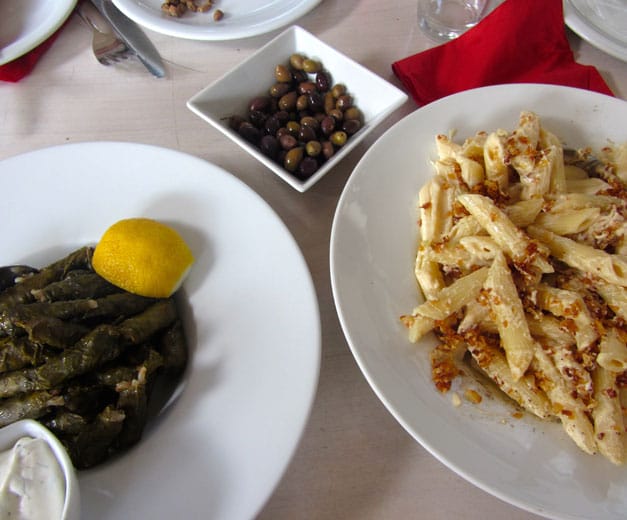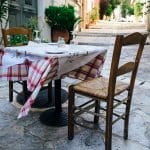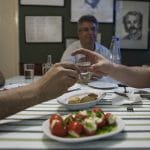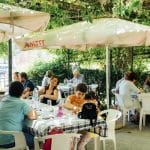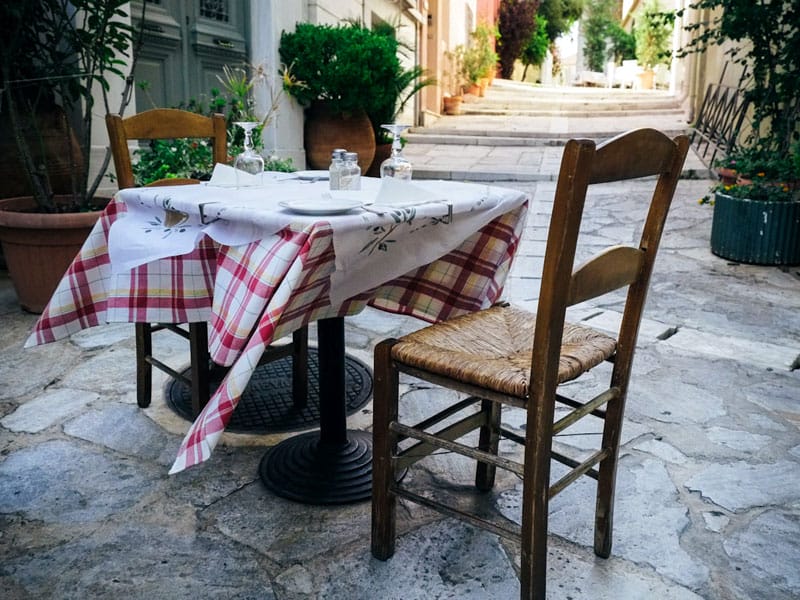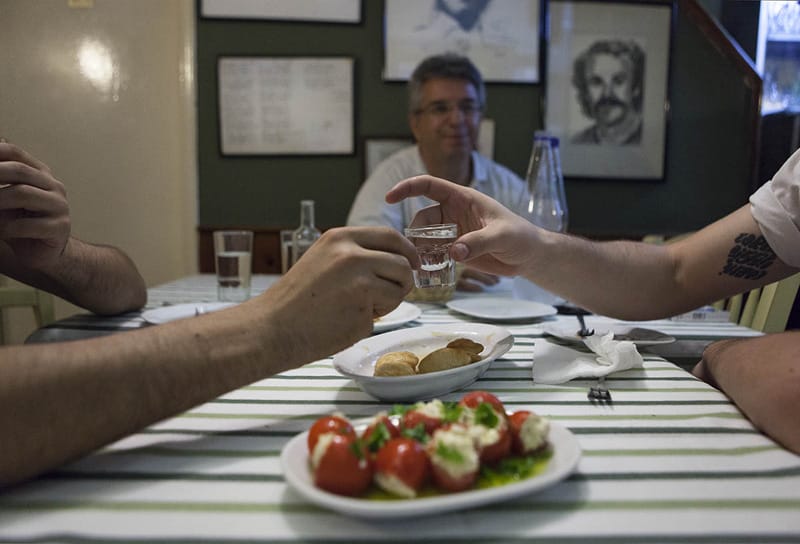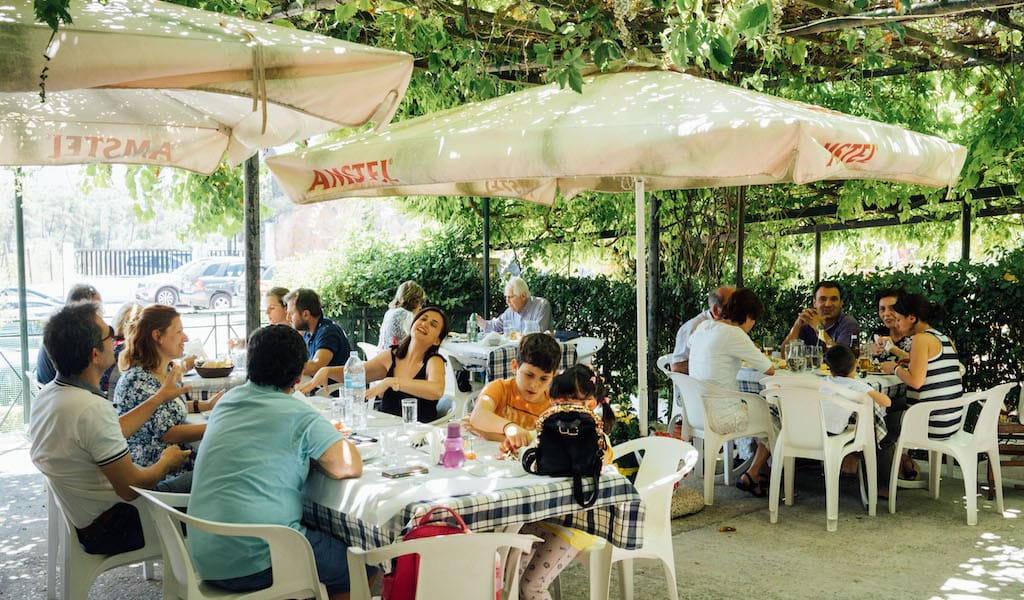Whether you’re a native Athenian or just visiting, Kypseli is not likely to be on your list of favorite haunts unless you happen to have roots there. It’s not connected to the Metro, it boasts neither museums nor fancy boutiques, and yet it must be one of the liveliest districts in Athens. The once elegant main street, Fokionos Negri, was the first to be pedestrianized and is wide enough to accommodate fenced green spaces where dogs can romp unleashed. A constant stream of people come and go, with lots of strollers and still more pooches – Kypseli must be the city’s most dog-friendly neighborhood – while the square at which it terminates throbs with groups of all ages and nationalities, who might be playing tag or kibitzing over dominoes. There are lots of foreigners but very few tourists.
Amidst this agreeable mayhem are some surprising restaurants, and our favorite at the moment has the improbable name of Bakalogatos, which has two meanings: “grocery cat,” i.e., a well-fed feline, or alternatively, the guy who runs around doing all the menial jobs. And indeed, the cover of the restaurant’s extensive menu depicts a scowling puss with a bulging tummy. But when we asked the owner of this family-run place about the name, Yiorgos Kandelis told us he christened it after the taverna in a classic 1960s movie called “Tis Kakomoiras,” even though there’s nothing miserable or seedy about it.
When we asked about why he and his wife and mother chose Kypseli, we got a longer answer. True, he was born and raised in Kypseli, but like most Athenians, the family’s spiritual home is really somewhere else, and in this case, it’s a very long way away: the tiny island of Kassos in the southern Dodecanese, between Karpathos and Crete.
Kassos claims no tourist attractions, few beaches, few vines and few trees. Its low hills have been carved into terraces supported by dry stone walls to keep precious earth in place. And because the island offered so little work, its people turned to the sea for their livelihood or to nearby Egypt. Kandelis’s grandparents were among the latter, and traveled to Ismailia, where jobs with the Suez Canal were plentiful. Kandelis’s mother was born there, but when her father retired with a well-lined wallet, it was to Kypseli they moved, not Kassos.
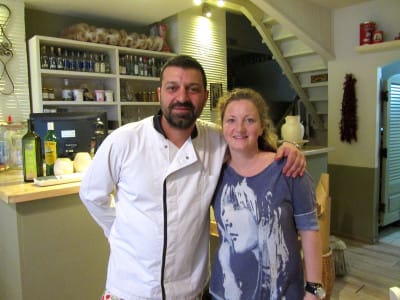 Nevertheless, the apartment looks like a folklore museum, full of antiques, costumes from all over Greece and the blue and white porcelain Kassiot seafarers collected on their travels. Kandelis promised to take us there on our next visit. For the time being, we had to be content with the plates and paintings decorating the Bakalogatos walls. Although we sat outside on that warm May evening, the interior’s pine floors, rush-seated chairs, the occasional rustic touch – strings of red peppers, a clay jar – and the play of pale green and cream in the color scheme made it very inviting.
Nevertheless, the apartment looks like a folklore museum, full of antiques, costumes from all over Greece and the blue and white porcelain Kassiot seafarers collected on their travels. Kandelis promised to take us there on our next visit. For the time being, we had to be content with the plates and paintings decorating the Bakalogatos walls. Although we sat outside on that warm May evening, the interior’s pine floors, rush-seated chairs, the occasional rustic touch – strings of red peppers, a clay jar – and the play of pale green and cream in the color scheme made it very inviting.
When Kandelis and his wife, Fanny, opened Bakalogatos in 2008, he already had many years of experience in the food business. “My first place was a café crêperie, which we started when I was 20. Then it turned into a café bar, and in 2000 we created a souvlaki/grill house called Anamena Karvouna (‘Lit Coals’), which was very successful. But I wanted a real restaurant that would offer Greek cuisine from all over the country with special emphasis on dishes from Kassos. In the beginning I had help from chef Panagiotis Papanikolaou, who’s also from Kassos with connections in Egypt. He taught me his secrets, basics with original twists.”
Listening to Kandelis talk about the menu whetted our taste buds. It may list as many as 70 dishes, representing most of Greece, divided into categories like “from the grocer’s,” saganakia (pan-baked and sauced), strapatzades (scrambled egg combos), potatoes, appetizers, tiganies (sautés) and intriguing choices like calf’s liver with orange, octopus with balsamic vinegar and a pork fillet sautéed with red Florina peppers, garlic and a balsamic demi-glace. But the Kassiot specialties interested us most. As blond, blue-eyed Fanny said, “You won’t be able to eat these dishes anywhere else in Athens.”
The only dish we already knew was the Kassiot version of dolmadakia, stuffed vine leaves no thicker or longer than a child’s pinkie and so succulent we could devour a potful on our own. Luckily, Kandelis had some simmering on his stove, but before we got to them, he started telling us about the little dishes, “from the grocer’s,” that Fanny had brought to our table: the tiny olives, the bite-sized sesame rusks and the kouloures – bagel-sized rings sprinkled with nigella seeds – and the bowl of sitaka cheese to dip them into.
The cheese is spreadable and looks deceptively like the spicy, fermented kopanisti of Mykonos, but instead is mild, only slightly tangy. Kandelis, passionate about Kassos products, began describing the lengthy process of making it, from sheep’s milk soured for a week in a cool place, then mixed with the same amount of fresh milk and cooked over a wood-burning fire for eight hours until it has been reduced by 90 percent. Even the type of wood plays a role, and because it must be stirred with a paddle all that time, people take it in shifts. Kandelis estimates that his special order of 25 kilos of sitaka from Kassos lasts about two months and adds that it also comes in a sweet variation made solely with fresh milk and flavored with mastiha and cinnamon for use in dessert pies.
At this point, having changed into his chef’s jacket and berry-patterned trousers, he invited us into the kitchen to watch him make another signature Kassiot dish, penne with sitaka and caramelized onions. He let us sneak a couple of dolmadakia straight from the pot and then proceeded to cream the sitaka with a bit of pasta water and brown the onions in plenty of clarified butter. The kitchen itself is remarkably small but highly efficient, with dozens of tubs of condiments and basic ingredients within easy reach.
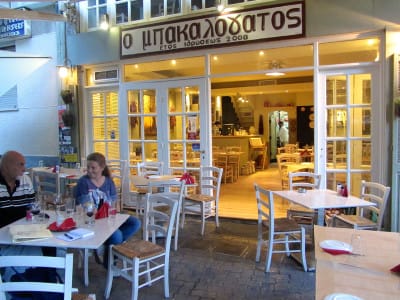 Back at the table, we were presented with a plate of the indescribably delicious penne, those irresistible dolmadakia and a carafe of the excellent house Merlot, followed by a luscious dessert called Malebi Politiko, a Constantinople-style custard flavored with homemade rose petal syrup, lemon flower water (anthonero) and pistachios, served attractively in a jam jar.
Back at the table, we were presented with a plate of the indescribably delicious penne, those irresistible dolmadakia and a carafe of the excellent house Merlot, followed by a luscious dessert called Malebi Politiko, a Constantinople-style custard flavored with homemade rose petal syrup, lemon flower water (anthonero) and pistachios, served attractively in a jam jar.
Other Kassiot specialties that will have to wait for another visit are spinach pie with rice and tomato, wild bitter stamnagathi greens lightly stewed, ink-blackened cuttlefish pilaf, and a pilaf served on the island on August 15 (Assumption Day), made with kid broth, a bit of tomato, beurre noir and cinnamon.
But you won’t find anyone in Bakalogatos in August. That’s when the whole family returns to Kassos “to charge our batteries.” They need to after working every day from noon to midnight the rest of the year.
Published on June 08, 2015
Related stories
June 28, 2013
AthensEditor’s note: This is the second piece in our series featuring the hidden gems in some of Athens’ most touristy neighborhoods. We previously explored Psyri; it is now time to take on the holy grail of Athenian tourism: Plaka. There’s a reason why this area of old Athens, just below the Acropolis, is the city’s…
July 24, 2012
AthensIt all started about six years ago, when Cretan cuisine – food from Crete, one of Greece’s largest and most famous islands – became fashionable in Athens. Suddenly, Cretan restaurants started popping up all around the city. Traditional Cretan dishes such as the rustic dakos (barley rusk in extra-virgin olive oil topped with finely chopped…
July 31, 2019
AthensGrowing up in Athens in the 1980s and 90s, weekend family excursions to a suburban taverna were an integral part of life. Back then, prices were affordable and eating out was not a luxury; in fact, it was a social necessity. It was a way to catch up with friends, enjoy good food and good…







































